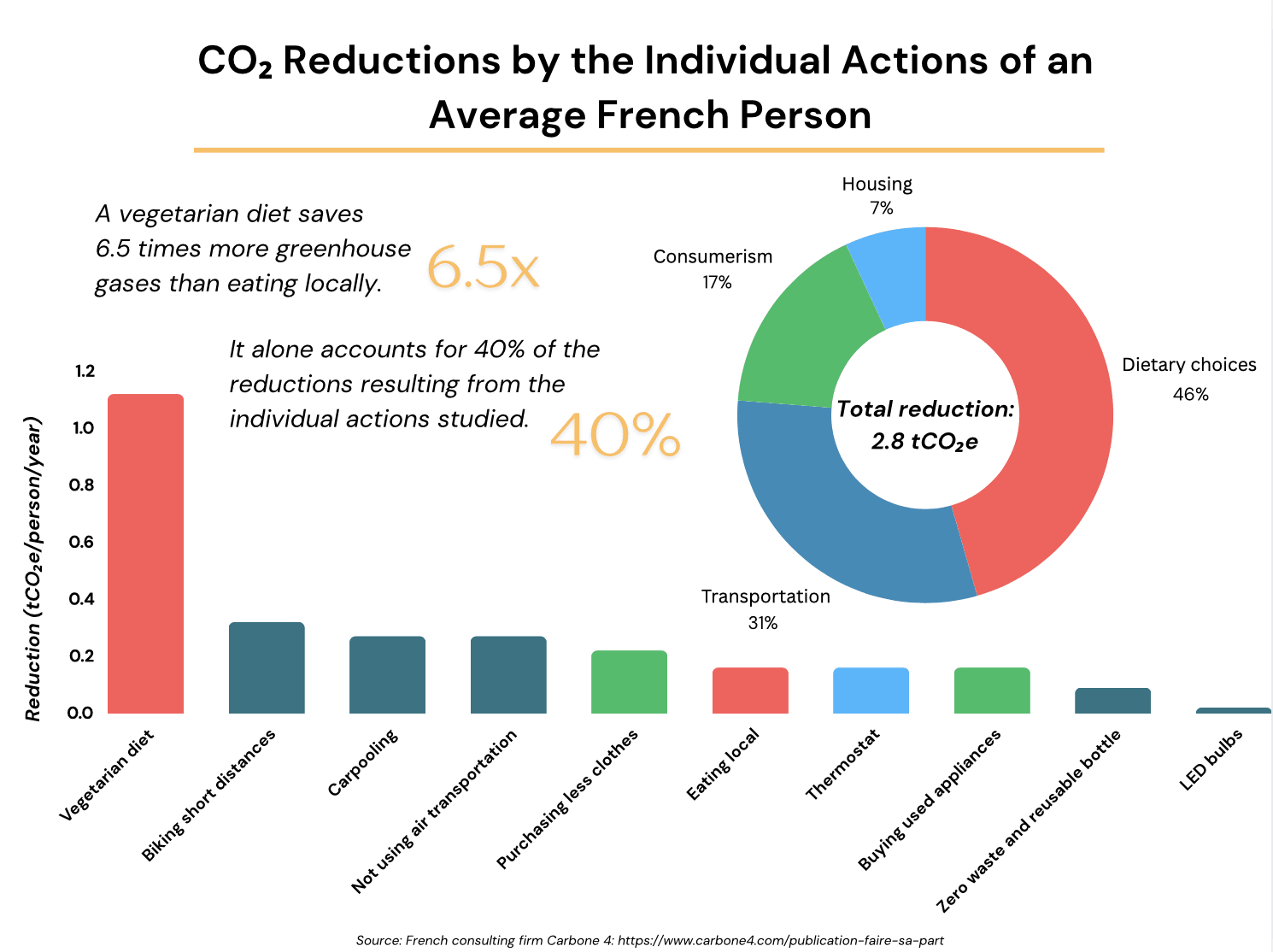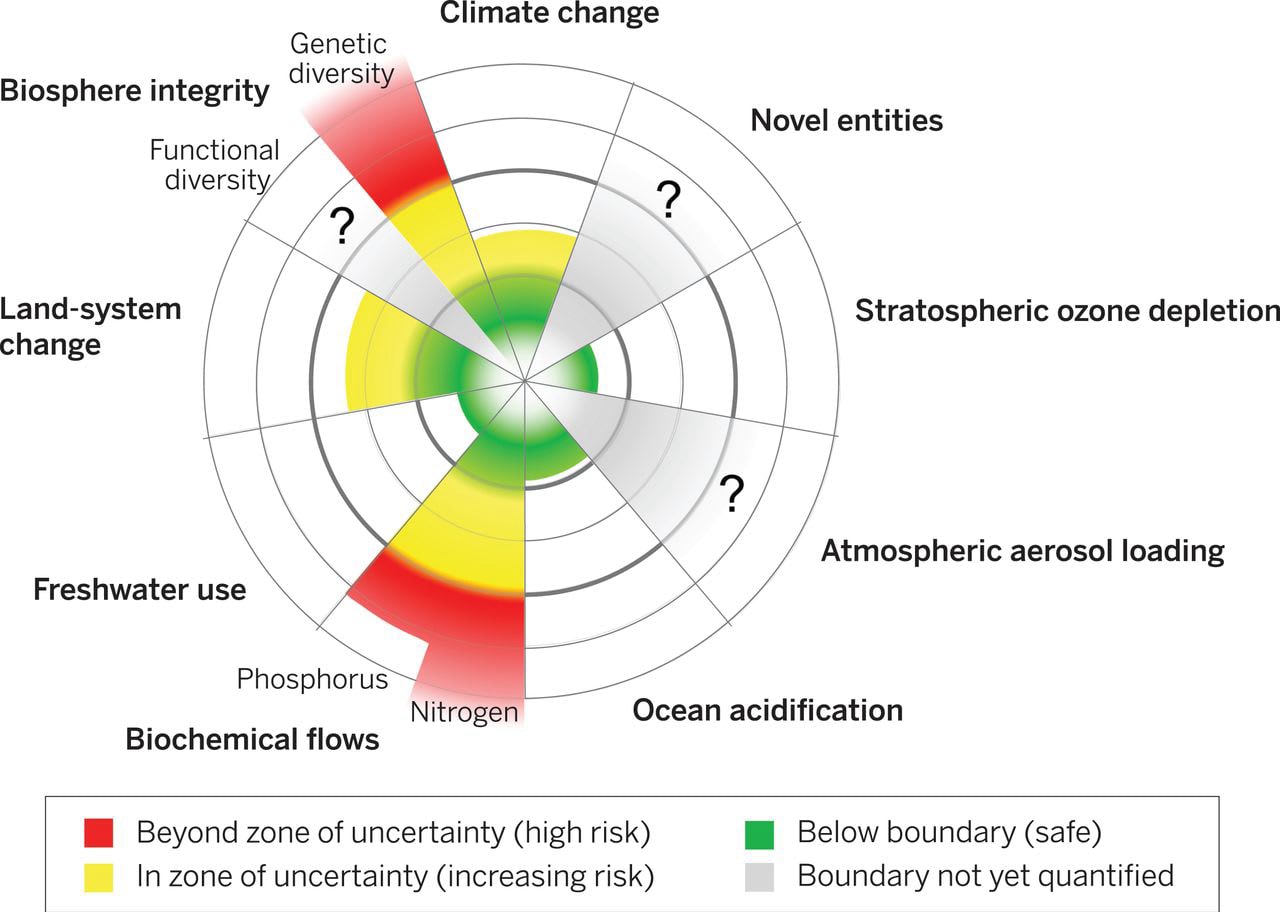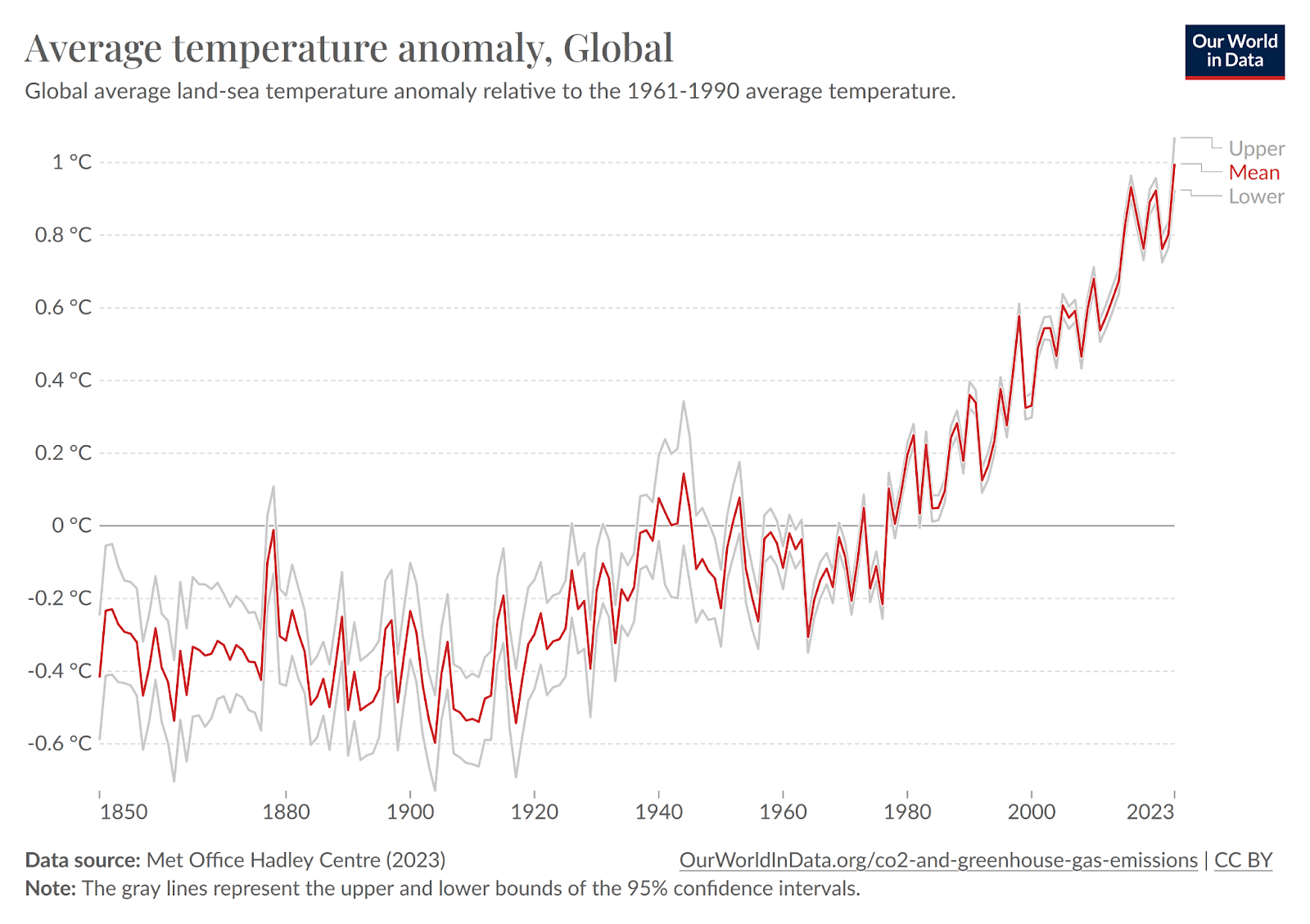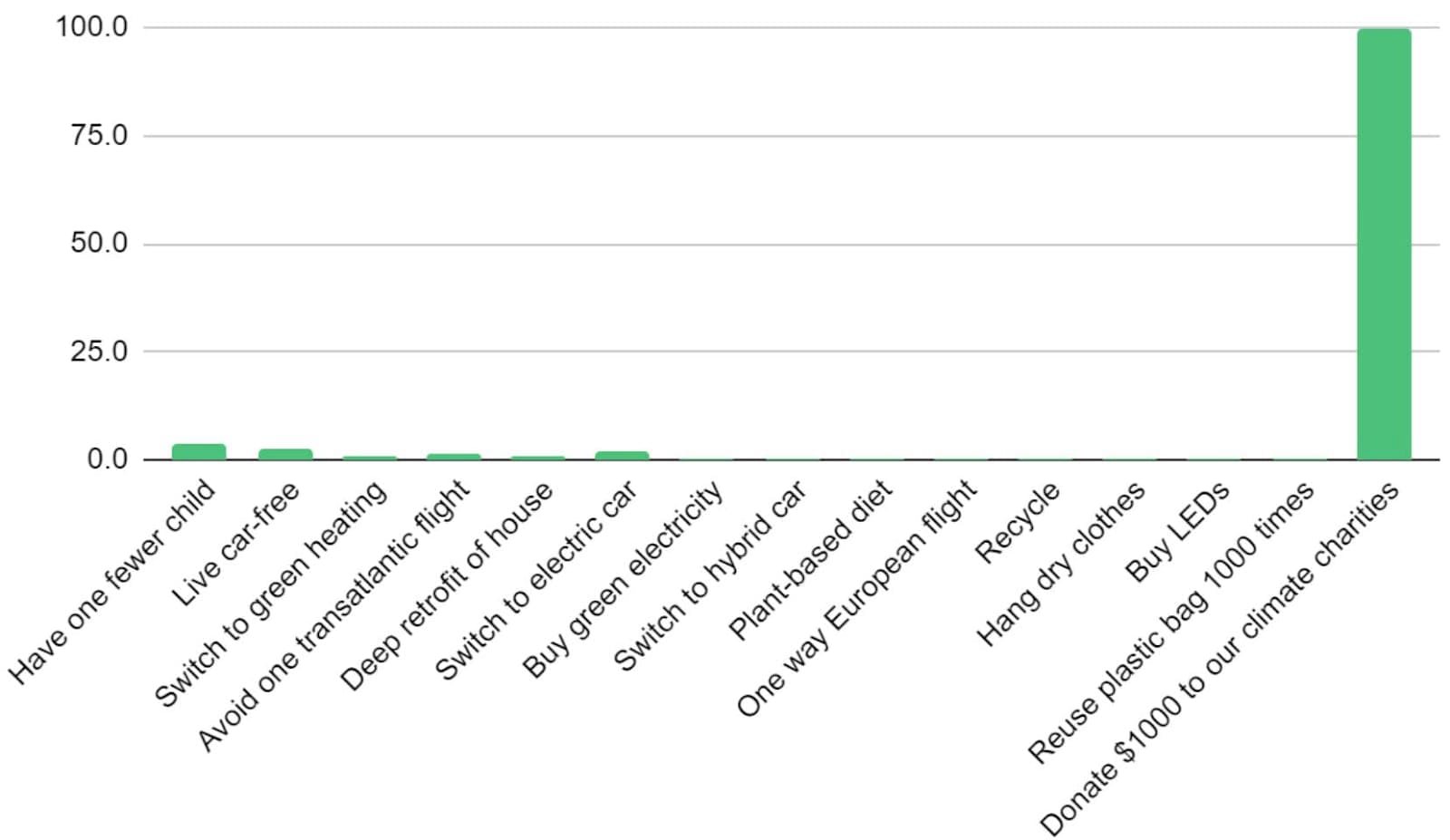TL;DR
- This post highlights impactful actions for the environment and explores why many people consider this topic important.
- Individual actions like adopting a primarily plant-based diet can have a significant positive impact, often outweighing other personal lifestyle changes.
- While individual action is positive, donating to high-impact charities can have a much higher impact than lifestyle choices. These organisations drive collective action and achieve feats that individuals can rarely do, such as influencing laws, technology, and societal norms.
- For instance, charities supporting alternative proteins are especially crucial, as meat consumption is the largest driver of deforestation and biodiversity loss. According to some estimations, donating to The Good Food Institute can prevent one ton of CO2 emissions for just around $3.
- Career change is another impactful opportunity.
Context
In 2023, EA France published a page summarizing many pieces of information and advice on how to contribute positively to the environment. We did so to:
- Answer popular demand: a lot of people outside (and also inside) of the EA movement look for resources in this area.
- Avoid the total absence of answers on a cause that seems top priority (and is top of mind) for many people who would also be interested in the movement's other resources, priorities and community.
This page is a translation of the admittedly long, long version people can find on our website. It's been abridged and edited to be more relevant for people residing in countries other than France. The page's main author @Corentin D. Biteau 🔸 has received several requests for translations. This is the translation, which we hope will be useful both to feed other initiatives and to receive feedback on our current document -we encourage you to both steal and criticize this work.
💡 If you are interested and want to learn more about ways to protect the environment, check out our "Effective ecology" program (in French)!
We need a healthy environment to survive, with access to clean air, unpolluted water, and a stable climate. Unfortunately, these vital elements are under attack from a multitude of threats. A growing number of us are looking to take action to preserve our world, but it is easy to feel helpless or lost in the face of the scale and complexity of the issues. However, there are a number of high-impact actions that can make a real difference. What actions can we take at our level to address these challenges?
Why is this important?
Humanity and other species rely on the stability of planetary ecosystems. When talking about the environment, global warming often comes to mind. Yet, as essential as it is, it is only one aspect of our challenges. Researchers from the Stockholm Resilience Center have introduced the concept of “planetary boundaries”, which assess the critical thresholds that the Earth system can support in the face of human pressures without compromising the living conditions of our species (and others).
Here is a list (far from exhaustive) of possible negative impacts on our societies:
Climate
If current trends continue, global CO2 concentrations and temperatures will be higher by the end of the century than they have been for tens of millions of years. Such warming has never happened so quickly, so its consequences are difficult to predict, but as research progresses, the speed and impacts of such warming seem worse than expected.
Climate change has already caused sea levels to rise, threatening islands and coastal cities, and leading to increased extreme weather events.
In June 2021, temperatures reaching 49.6°C were observed in Canada. In France, by 2030, the temperatures experienced during heatwaves in 2003 and 2022 will be considered as "normal" summers.
Climate warming could compromise access to basic resources such as water, endangering food security in many countries and putting hundreds of millions of people at risk. Some regions of the world could become uninhabitable due to heat, and mass migrations could increase tensions. For more information on these risks, see this report and the Climate Impact Lab website.
Biodiversity
Human activity has also led to an alarming loss of biodiversity: the current extinction rate is 1,000 times higher than the average and could be even more rapid than during the disappearance of the dinosaurs 65 million years ago. In France, one-third of countryside birds have disappeared in 15 years. According to the insurer Swiss Re, nearly 55% of the world's GDP depends on biodiversity (clean water and air, wood, fertile soils, pollination, coastal protection…), while one in five countries is at risk of ecosystem collapse.
The greatest threats to biodiversity are land use change for agriculture, direct exploitation (including fishing, which is the first threat to marine biodiversity), climate change, pollution and invasive species.
Moreover, the destruction of wildlife habitats is not only a major factor in their disappearance but also a factor in pandemics, accounting for more than 30% of new diseases that have emerged since 1960. Indeed, when the habitats of animals are destroyed, they are forced to move to areas inhabited by humans, inadvertently bringing their viruses, which can then be transmitted to humans.
Energy resources
Our industrial civilization is highly dependent on abundant and cheap energy, 85% of which currently comes from fossil fuels (oil, coal, gas). There are good reasons to believe that fossil fuels will start to decline in the coming decades (Saudi Arabia, for example, has announced that its peak production will be reached by 2027). Renewable alternatives are improving, and their cost for electricity production has significantly decreased, but it is uncertain whether they will replace fossil fuels quickly enough, particularly for trucks, heavy industry, and fertilizers. The availability of the metals needed for the transition is also a concern and could be a major obstacle. Above all, a significant decrease in available energy is likely to be accompanied by a sharp economic decline. For more information, see this article in English written by one of our members.
Water
Significant limits have also been breached regarding water resources: "Water is the bloodstream of the biosphere. But we are profoundly altering the water cycle. This will affect the health of the entire planet and make it much less resilient to shocks." The amount of extractable freshwater has dropped by 35% since 1970 due to the depletion of groundwater and the destruction of wetlands. The major factor in this over-extraction is agriculture (particularly for animal products, as indicated below).
Pollutions
There are other forms of pollution besides greenhouse gasses, and many chemical compounds are now present in the environment.
- Plastic pollution is particularly visible (and a significant portion of it comes from fishing). The best approach to combat this pollution seems to be better waste management.
- Lead pollution affects one in three children, causes more than 900,000 deaths per year, is a major factor in crime, and the economic costs are estimated at 5-8% of GDP in some low-income countries.
- Finally, the combustion of fossil fuels, in addition to causing climate change, kills millions of people each year due to air pollution.
Combined Impact of These Different Factors
Finally, these combined factors are likely to lead to an increase in other global catastrophic risks due to heightened political instability from mass migrations and growing competition for certain resources (see this article). There are already 2,500 armed conflicts ongoing worldwide over fossil fuels, water, food, and land. Tensions related to water scarcity could, for example, contribute to increased tensions between states, with all the potentially dramatic consequences this could imply (India and Pakistan, in particular, both have nuclear weapons).
How Can We Address These Challenges?
Environmental protection is crucial but intricate. We consulted experts to identify impactful actions, revealing a consensus: pinpointing the most effective organizations and interventions is challenging.
Environmental problems are, by nature, large-scale (national or global) and are caused by the way our societies function. They therefore require a transformation of our lifestyles, notably through changes in public policies. This greatly complicates the evaluation of what works and what doesn't. Moreover, there are many different approaches that are difficult to compare, given that they influence different issues and on different temporal and territorial scales. Much of the work of associations is unquantifiable.
Finally, the problems are interconnected, meaning that solving one issue, such as climate change, can shift the impact elsewhere (resources, biodiversity, water, resilience...). No single approach seems sufficient to address all these challenges simultaneously. It is a systemic problem. Yet, very few organizations tackle it on this scale.
Our initial intention was to create a map to determine with certainty the most effective French organizations for the environment. For the above reasons, such a project no longer seems possible.
Despite these challenges, we continue our research and will update our website with new information as we progress. Indeed, despite these uncertainties, we have been able to identify some neglected but promising strategies. The following approach will necessarily be incomplete and will not allow us to act on all fronts at once. Nevertheless, we have strong reasons to believe that the interventions presented below have a much greater impact than average.
Three criteria were particularly important to do this: impact, tractability, and neglectedness. Let's detail this:
1/ Tackling a Large-Scale Problem
It is essential to tackle the largest issues first. For example, when we think about eco-actions, what often comes to mind is recycling, eating locally or changing your bulbs. To determine whether these are really the most promising levers, the Carbone4 firm compared individual actions based on their ability to reduce one’s carbon footprint (indicative data over one year):

This chart excludes the purchase of an electric car and home insulation, which require a more significant investment. It is also important to remember that the above data are averages, which smooth out certain disparities (one in three French people has never taken a plane, while others take it regularly). It is also worth noting that, aside from daily mobility—something not everyone can easily adjust (for instance, cycling may be impractical if work is 20 km away)—these options are often more affordable. Meat, air travel, and new clothes are often expensive. Additionally, some suggest that having one less child can have a considerable impact compared to other actions - although this is a sensitive topic and a very personal decision.
The disproportionate impact of switching to a vegetarian diet might surprise us, but it makes more sense when we know that animal farming causes 20% of carbon emissions and is the leading cause of deforestation (see below).
On the other hand, it can be noted that eating local and having zero waste has a limited impact on the climate issue, even if they can be positive on other aspects (the impact of organic products is more mixed: depending on the indicator and the food considered, they may be better or worse than conventional products). Carbon emissions from food transport and packaging are typically very low.
Plastic and Waste - a Smaller Impact Than Expected?
In the public space, there is thus a mismatch between the most well-known and the most effective eco-friendly actions. A study conducted in Germany examined people who considered themselves green consumers and observed that, in general, they did not have a lower ecological footprint than average!
In fact, they wished to act sustainably, but the actions they had in mind were often low-impact (light bulbs, tote bags, recycling…) and weighed little compared to factors like the size of the house, the number of household appliances, meat consumption, flights, etc. Consuming better is possible but requires a lot of research and offers few guarantees. According to the study, the first determinant of environmental impact is… wealth. Indeed, the more means one has, the more one can consume.
2/ Focus on the Most Achievable Progress
The second factor is tractability: choosing actions where significant progress can reasonably be expected. For example, changing individual behaviors is a complicated switch to flip. The previously cited Carbone4 report emphasizes that a large part of our impact is determined by our technical, social, and political environment, which is more likely to be changed by intervening at the collective level.
3/ Tackling a Neglected Problem
There is a greater chance of making a difference by addressing a problem where few other actors are engaged. For example, reforestation interventions are relatively well-funded (at least $5 billion through various foundations) and approached from different angles (protection of indigenous peoples' territories, creation of protected areas, agroforestry...). Similarly, decarbonized electricity production and electric mobility receive a lot of attention. In comparison, topics such as heavy industry, heavy transport (trucks, container ships), or agriculture are more neglected.
What Are the Most Promising Interventions for the Environment?
By following these criteria, we can identify interventions that could have a significant impact. For the reasons mentioned above, we will not detail the numerous possible individual actions, but we will emphasize an often underestimated recommendation: donating to high-impact organizations.
Regarding climate change, the most effective organizations can prevent approximately one ton of CO2 for less than $10 (or even much less - down to 1$ per ton of CO2). In comparison, CO2 capture from the air costs around €1250 per ton of emissions avoided. Here’s what such a donation can achieve compared to the most common eco-friendly actions.
Carbon impact of the most effective individual actions (in tonnes of CO2 equivalent) compared to the impact of a donation to organizations avoiding one tonne of CO2 for less than $10. A French person emits ~10 tonnes per year (note this is an average). Source: Founders Pledge.
Thus, the potential impact of a generous donation (to the most effective organizations) can be much greater than most eco-friendly actions. This estimate was produced by looking at the past successes of these organizations and the emissions they have been able to avoid relative to the budget allocated. Such a figure must, of course, be taken with caution, and any methodology for such a calculation has significant limitations given the complexity of measurement—see the report here that explains the reasoning (for example, the calculation for “having one less child” differs from other studies). We should also take into account that individual actions have a comparatively more "certain" impact—they thus have a role to play.
Even with its limitations, this estimate allows us to grasp the large differences in impact. Additionally, the median estimates of the evaluators include uncertainty bars and are often less than $10 per ton.
Such a difference may seem surprising, but it is explained by the fact that these organizations act at a collective level. As an individual, it is generally difficult to influence the political and economic system, which has a large impact on sustainability. Few of us have the network or the skills needed to influence legislators or companies. However, supporting (financially or by volunteering time) those who have these skills and this network can achieve greater changes. Unlike carbon offsetting, this helps to generate systemic change.
However, not all organizations achieve such results, far from it. How can we identify them? To do this, we relied on the work of Giving Green, an evaluator that has conducted extensive research to assess promising interventions and organizations. They have analyzed many strategies, relying on solutions from Project Drawdown, feasibility studies, and discussions with experts (see their approach). A limitation of their approach is that they focus solely on climate (as this is where most of the data is), but the third recommendation addresses several planetary boundaries simultaneously.They identified three avenues, for which we will mention their recommendations.It is also important to note that we have favored underfunded organizations that generally have less visibility—you will therefore find few well-known organizations here.
1/ Policy Advocacy
Policy advocacy aims to enact laws that better account for the environment. This can be achieved by raising public awareness on a large scale or establishing a dialogue with policymakers or legislators.
Giving Green recommends the Clean Air Task Force (CATF) and the Evergreen Collaborative, which engage in political advocacy and have played a key role in the adoption of the Inflation Reduction Act in the USA. CATF is also active at the European level, including in France.
The Citizen Climate Lobby (CCL, operating in multiple countries) advocates for the implementation of ambitious carbon pricing coupled with a national climate dividend. This initiative is largely supported in the academic community, could positively impact the economy, employment, and public health, and is already implemented in Canada, Switzerland, and Austria. CCL is not tax-deductible, but it trains citizens to propose this law to their members of parliament, often with positive feedback.
2/ Technological Improvement
This involves supporting research for the decarbonization of heavy industry and energy. Heavy industry, including cement and steel production, is responsible for a third of greenhouse gas emissions, making it a crucial action item. Giving Green recommends Industrious Labs, which advocates for corporate commitments on the issue, regulations, and public support for research.
Another approach is low-carbon energy, particularly through small modular reactors (SMRs). The Good Energy Collective seeks to advance public support for research in this area. This approach also helps to combat air pollution.
However, debates persist about the effectiveness of energy decarbonization, as new carbon-free energy sources can add to the total energy consumption instead of simply replacing fossil fuels. This suggests that new technological solutions should be complemented by political action aimed at reducing consumption.
3/ Reducing Consumption of Animal Products
This is one of the most important actions, and its impact goes beyond climate. Indeed, as indicated below, meat consumption is the primary cause of deforestation and biodiversity loss. A report by the Institute of Physics in 2015 stated that livestock farming was responsible for 78% of terrestrial biodiversity loss in Europe.
It is also the main source of water pollution, a significant source of animal suffering, and a major factor in pandemics. For example, the French Agency for Ecological Transition (ADEME) recommends a reduction of 30 to 70% in meat and animal product consumption to meet climate goals in its most realistic scenarios, but current legal measures are insufficient in this regard.
Donating to organizations aiming to reduce meat consumption thus has a particularly positive impact on the environment.
In particular, Giving Green recommends The Good Food Institute, which supports research for alternative proteins and can avoid a ton of CO2 for about 3$. It is important to make meat alternatives accessible, affordable, and tasty. These alternatives emit up to 90% less greenhouse gasses and are increasingly accepted, as evidenced by fast-food chains like Burger King offering a veggie burger by default on their menu. You can find more information and support them here.
Are There Reasons Not to Prioritize This Cause?
Some people decide not to prioritize working on the environment for the following reasons:
The Topic is Complex
As we have seen, the topic is very complex, with many interconnections between the different elements. Given the time required to observe concrete results and the difficulty in reversing certain current power dynamics, some believe their resources would be better used in other causes with better-understood solutions.
Other Issues May Seem More Neglected to You
More and more people consider this a significant issue and are acting on it, which makes the environmental issue far less neglected than other issues we address, although current efforts remain insufficient. For example, climate-related spending probably exceeds $640 billion per year. This vast amount of resources invested means it is more difficult to find high-impact opportunities that have not already been explored, even though it is likely that some specific areas do not receive as much attention as they should.
Therefore, some redirect their efforts to much less funded areas that may present an even greater risk of catastrophe (potentially leading to extinction), such as fighting global catastrophic risks (pandemic risks, nuclear war, the development of dangerous AI, etc.).
Working in This Domain
Working in the environmental sector can take various forms depending on your skills and interests. With a background in science or engineering, consider working on the development of clean technologies or climate research. If you are more interested in the political aspect, a career in advocacy or environmental law could suit you. Many other options are possible. For example, working on alternative proteins can be promising.
Several resources can guide you, such as the impact careers guide from Effective Environmentalism. The 80,000 Hours website also offers career advice, particularly on climate change.
In any case, it is important to identify the levers that can have the most significant long-term impact. Given the diversity of topics, there are many different approaches, and choosing one that is particularly impactful can make a big difference.
Learn More - Resources in English
- Effective Environmentalism visually summarizes the effectiveness approach to this topic and provides a wealth of resources.
- On the topic of climate, see the articles by Giving What We Can and 80,000 Hours, as well as the association recommendations by Founders Pledge.
- Our World in Data, especially their section on the impact of food.
- The Post Carbon Institute and Resilience.org provide relevant analyses on the ecological crisis, as well as online training. Also see their Museletter.
- The animated video "The Great Simplification" provides many insights in 30 minutes on how humanity got here and how economic, energy, and environmental systems are interconnected. The book "Reality Blind", by Nate Hagens, delves deeper into the subject (available for free). A dedicated podcast also interviews experts.
- On biodiversity, see the Ecoresilience website, as well as this post.
- Carbon Brief is an excellent source of information on all things climate-related.
Your Comments
As previously mentioned, the conclusions presented here are based on the data available and are certainly not exhaustive. We invite you to consult the sources we reference. If you notice an error, or if you have suggestions for improvement, please let us know your comments.
This page includes excerpts from the book "Agir pour un Monde Durable" by Pascale Fressoz and Corentin Biteau, with permission from the authors (Jouvence editions). Other excerpts from this book, including action plans and practical methods on the theme "how to find other sources of well-being if endless consumerism is not sustainable," are available in French on this link.




Thanks for the post! I think the best interventions in animal welfare are much more cost-effective than the best decreasing greenhouse gas (GHG) emissions. I estimated Founders Pledge’s (FP's) Climate Change Fund (CCF), which I consider to be the best donation option to decrease GHG emissions, has a cost-effectiveness of 0.0326 DALY/$. I calculate this is only 0.710 % (= 0.0326/4.59) as cost-effective as cage-free campaigns helping hens, and 0.00510 % (= 0.0326/639) as cost-effective as the Shrimp Welfare Project (SWP) has been.
This is a useful complement, thanks!
Providing these numbers puts things into perspective.
The goal of this post was initially to suggest impactful actions for people already interested in the environment. However, you are definitely right to offer a comparison with other cause areas. This is very useful information for people who are cause-agnostic.